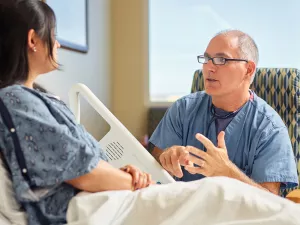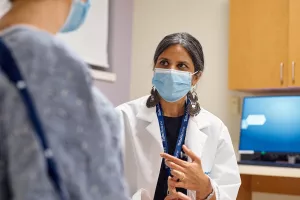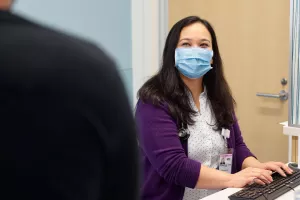Vascular diseases like peripheral artery disease and carotid artery disease can take a toll on how blood vessels circulate blood, nutrients and oxygen throughout the body. Whether you need emergency or preventive care, we use the latest endovascular procedures to restore healthy blood flow.
Compassionate care runs through our veins
There are 3 types of blood vessels that make up your vascular system, and each one plays an important role in maintaining healthy blood circulation:
- Arteries carry blood away from the heart
- Veins carry blood toward the heart
- Capillaries connect arteries and veins
Your arteries make up a superhighway for blood flow that stretches roughly 60,000 miles, or enough to circle the world more than 2 times. The same goes for your veins. When something as complex and delicate as your vascular system isn't working as it should, it can have a major effect on your health and quality of life.
At Tufts Medicine, our team includes some of the brightest minds in vascular medicine. Together, we can detect, diagnose and treat the full range of vascular conditions and diseases, from varicose veins to heart attacks. And if you ever have questions or just need to talk, we'll be there for you.

Conditions
When you know or suspect something is off with your vascular health, you can trust in our specialists to diagnose and treat the following vascular conditions:
Vascular disease symptoms
When a vascular condition affects your body or causes pain, it can impact your quality of life or even become life-threatening. Get in touch with your doctor if you’re experiencing any of the following vascular disease symptoms in your arms, legs, hands or feet:
- Abnormal color changes
- Coolness or coldness
- Numbness or tingling
- Pain
- Swelling
- Ulcers or wounds that don’t heal
Signs of a heart attack
The vascular system has the important job of circulating blood throughout the body, including to the heart. When blood flow that delivers oxygen to the heart suddenly becomes blocked, a person can experience a myocardial infarction, better known as a heart attack.
The sooner you’re treated for a heart attack, the more likely it is that you’ll avoid life-threatening damage to your heart. If you notice any of these major heart attack signs, call 911 or visit an emergency room immediately:
- Chest pain or discomfort
- Feeling weak, light-headed or faint
- Pain or discomfort in one or both arms or shoulders
- Shortness of breath
Women and assigned females at birth (AFABs) sometimes experience slightly different heart symptoms. Additional signs of a heart attack in women include unexplained tiredness, nausea and vomiting.
Testing
We use the latest cardiovascular imaging technologies to get a clear picture of your heart and blood vessels. Your doctor will likely recommend the following imaging tests to look for blockages, reduced blood flow and other vascular abnormalities:
- Cardiac MRI
- CT scan
- Echocardiogram (“echo”)
- Stress echocardiogram
- Electrocardiogram (EKG)
- Nuclear medicine
We also use advanced diagnostic tests to learn even more about your vascular system, such as:
- Catheter-based digital diagnostic angiography
- Intravascular ultrasound
- Invasive diagnostic angiography
- Noninvasive vascular hemodynamics and duplex ultrasound imaging
Treatments
To restore the flow to your vascular system, we collaborate with our colleagues in cardiology, endovascular surgery, interventional radiology, podiatry and vascular surgery. Together, we’ll work with you to create a treatment plan that delivers comfort and a higher quality of life.
Endovascular surgery uses catheters to perform minimally invasive procedures. Rather than making an open incision, endovascular procedures involve making small punctures in the skin, and then threading catheters through arteries and blood vessels to treat the affected area.
We use the latest endovascular techniques like laser ablation as well as minimally invasive procedures like transcatheter aortic valve replacement (TAVR) to get your vascular health back on track.
Angioplasty, or percutaneous coronary intervention (PCI), is one of the go-to treatments for a heart attack. An angioplasty can be an emergency treatment (primary) or a way to prevent a heart attack (non-emergent).
Primary angioplasty
Even just a few moments can be the difference between life or death during a heart attack. Our surgeons are ready to perform a primary angioplasty when you come through our doors. Here’s how it works:
- Thin, flexible tubes called catheters are inserted into a blood vessel and guided toward the heart.
- Dye is then injected through the catheters to help locate the exact location of the blockage.
- A tiny balloon at the end of the catheter is then inflated to widen the blocked artery, allowing blood to flow more freely.
- In some cases, we use a tiny metal tube called a stent to keep the artery unblocked.
Non-emergent angioplasty
A non-emergent angioplasty is very similar to a primary angioplasty, but the key difference between them is when they’re performed:
- A non-emergent angioplasty is performed before a heart attack even happens.
- A primary angioplasty is performed immediately following a heart attack.
This is a preventive procedure that your care team may recommend to lower your risk of heart attack or other vascular diseases.
Whenever possible, our surgeons will choose minimally invasive procedures to help heal your vascular system. What sets minimally invasive surgeries apart from more invasive, open surgeries?
- A lower risk of infection and complications
- Quicker recovery times
- Less blood loss
Laser ablation
A laser ablation is a minimally invasive technique where we use a catheter that delivers controlled heat energy to treat abnormal veins. During the procedure, the catheter is placed into the vein through an incision roughly the size of a paperclip. The laser heat helps eliminate the diseased part of the vein while protecting healthy tissue.
Transcatheter aortic valve replacement (TAVR)
Transcatheter aortic valve replacement (TAVR) is a smart treatment option for people over age 70 living with aortic stenosis.
During TAVR, a prosthetic valve is delivered to the heart via a catheter. We carefully position the prosthetic valve in your heart and expand it. As the new valve expands, it pushes your diseased valve out of the way and takes over the job of regulating blood flow.
Awards + accreditations
Tufts Medical Center and MelroseWakefield Hospital are recognized by U.S. News & World Report for heart failure treatment. Tufts Medical Center is recognized by Healthgrades for stroke care.

From regular office visits to inpatient stays, find the healthcare you need and deserve close to home.

Meet the doctors and care team devoted to supporting you every step of the way along your path to better health.